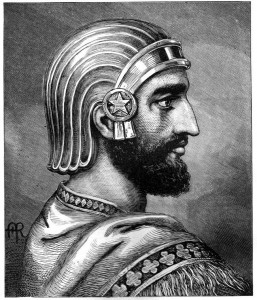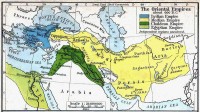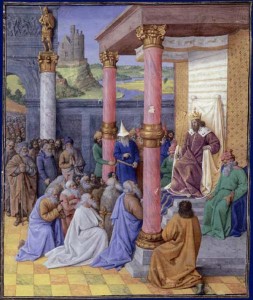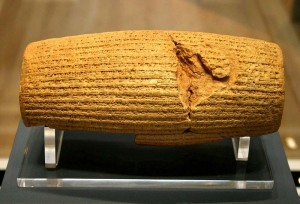| Cyrus the Great | |
|---|---|
 |
|
| Ancient King of Persia | |
| In Power | 559 B.C.-530 B.C. |
| Born | 600 B.C. or 576 B.C. Anshan |
| Died | 530 B.C. Along the Syr Darya River |
| Buried | Pasargadae |
| Royal House | Achaemenid |
Cyrus The Great Ruled the largest Empire of his day, and is known for granting many freedoms to his subjects. Over the centuries many kings and conquerors have been given the moniker, “The Great,” but some say that the figure who deserved this title the most was Cyrus the Great, the ancient King of Persia.
Even though he was born and ruled more than 2,500 years ago, many modern leaders today still claim Cyrus as their primary inspiration and hero. He was a brilliant military leader, but he is even more revered as a wise and tolerant ruler. Once Cyrus conquered a nation he allowed those other realms he absorbed to manage themselves and to keep their customs and religions. Cyrus was said to have respected the basic human rights of the common man more than any other ruler of his time.
Beginnings
According to historians, Cyrus was either born in 600 or 575 B.C. He lived in Persia, a location that, today, would be within the country of Iran. His father was Cambyses I, King of Anshan, and his grandfather was Cyrus I, ruler of Anshan before his father.
Cambyses I died in 551 B.C., making Cyrus the Great king in 559 B.C. Cyrus was between 25 and 40 years old. At the time, Cyrus’ power was divided between a number of other powerful states in the region, with the Median Empire holding a large amount of influence over Anshan. During this time, Cyrus was subservient to the Median King and was required to pay homage to him.
Becoming the King of Persia
With the help of a rogue Median general, Harpagus, Cyrus revolted against the entirety of the Median army and conquered them in 549 B.C. Upon his victory, Cyrus was able to combine Anshan with the newly defeated empire and crowned himself the King of Persia for the first time.
Defeating the Lydian Empire and Asia Minor
 The dates of Cyrus’ Lydian conquest are unknown, but historians believe that it occurred sometime between his defeat of the Medians and his acquisition of the Neo-Babylonian Empire. The Lydian Empire and Asia Minor covered vast amounts of land, some of which extended into the modern-day areas of Greece and Macedonia. A number of notable battles took place throughout the campaign, including the Battle of Pteria, which resulted in a stalemate and left heavy casualties on both sides. After losing many men, the opposing ruler, Croesus, retreated to his capital city in Sardis. Cyrus followed him and besieged him capital at the capital, where he successfully defeated the enemy cavalry and captured the city at the battle of Thymbra. His empire continued to spread across the Middle East.
The dates of Cyrus’ Lydian conquest are unknown, but historians believe that it occurred sometime between his defeat of the Medians and his acquisition of the Neo-Babylonian Empire. The Lydian Empire and Asia Minor covered vast amounts of land, some of which extended into the modern-day areas of Greece and Macedonia. A number of notable battles took place throughout the campaign, including the Battle of Pteria, which resulted in a stalemate and left heavy casualties on both sides. After losing many men, the opposing ruler, Croesus, retreated to his capital city in Sardis. Cyrus followed him and besieged him capital at the capital, where he successfully defeated the enemy cavalry and captured the city at the battle of Thymbra. His empire continued to spread across the Middle East.
Neo-Babylonian Conquest
 Cyrus the Great next acquired Neo-Babylonian Empire which encompassed a number of sub-nations, including Syria, Judea and lands within the Arab realms. The dates of his conquest of Babylon are somewhat disputed, but most agree that it was around 539 B.C. At this point, Cyrus proclaimed himself the King of Babylon, King of Sumer and King of Akkad.
Cyrus the Great next acquired Neo-Babylonian Empire which encompassed a number of sub-nations, including Syria, Judea and lands within the Arab realms. The dates of his conquest of Babylon are somewhat disputed, but most agree that it was around 539 B.C. At this point, Cyrus proclaimed himself the King of Babylon, King of Sumer and King of Akkad.
The Achaemenid Empire
The Achaemenid Empire, sometimes called the First Persian Empire, was the collective name given to the various nations that Cyrus had conquered. At his death, it encompassed lands to the east by the Indus River valley and extended west to the fringes of Greece and Macedonia. Cyrus was killed in battle before he could conquer Egypt to the south, but Egypt eventually came under the rule of the Achaemenid Empire when his son conquered it after him. The name Achaemenid was taken from a legendary King of Persia who had lived about 200 years before the time of Cyrus. In adopting the name of Achaemenid, Cyrus the Great was laying claims to ancient titles and hearkening back to a time when his people were considered the mightiest people on the planet.
The Cyrus Cylinder
Among the most famous relics recovered from Cyrus the Great’s reign is the Cyrus Cylinder, which was kept in the temple of Marduk in Babylon. This is a 10-inch by 4-inch clay cylindrical object imprinted with information about Cyrus’ conquest in Babylon and is considered by some to be an early affirmation of human rights. The cylinder also included political edicts which improved the lives of Babylonian citizens and information regarding grants of freedom to a number of groups, including the Jews of Babylon, who had long been enslaved by the rulers of that realm.
There general population was quick to adopt the ways of Cyrus the Great as he also allowed for the practices of cults and other religious groups.
Death and Tomb
Cyrus the Great died in battle around 530 B.C and was succeeded by his son Cambyses II. He was buried in a pyramid-like tomb in Pasargadae, which is located in modern day Iran.
